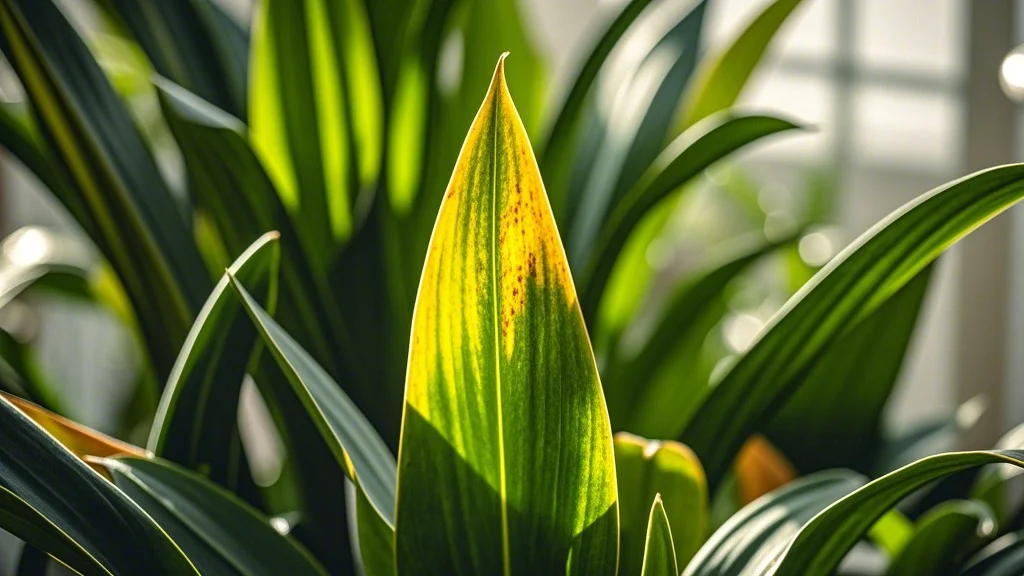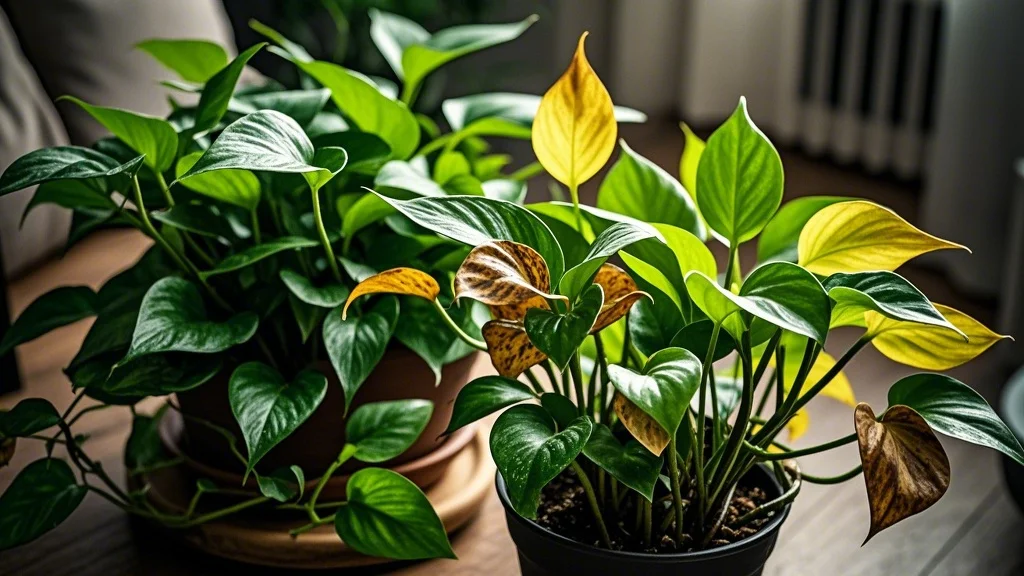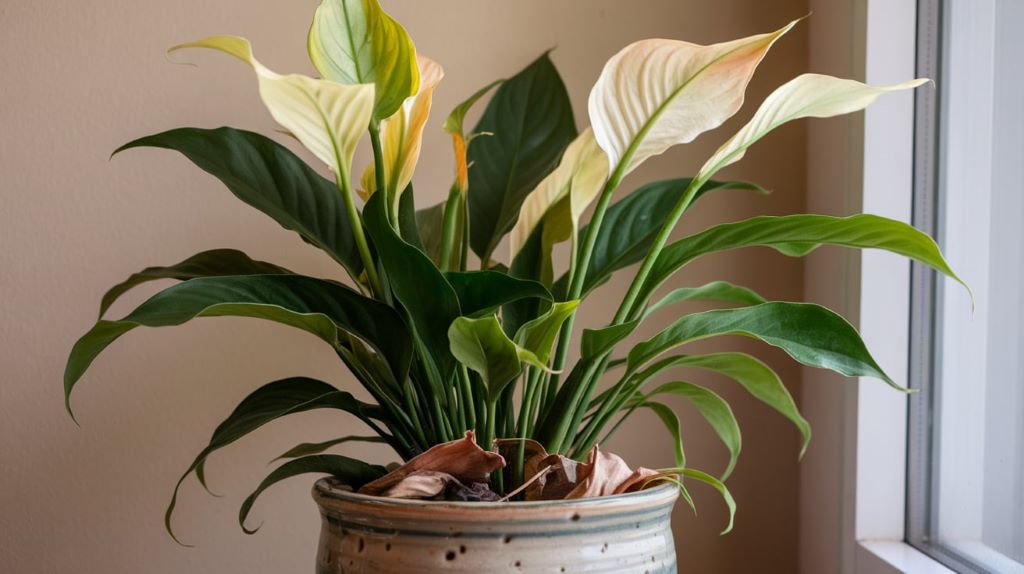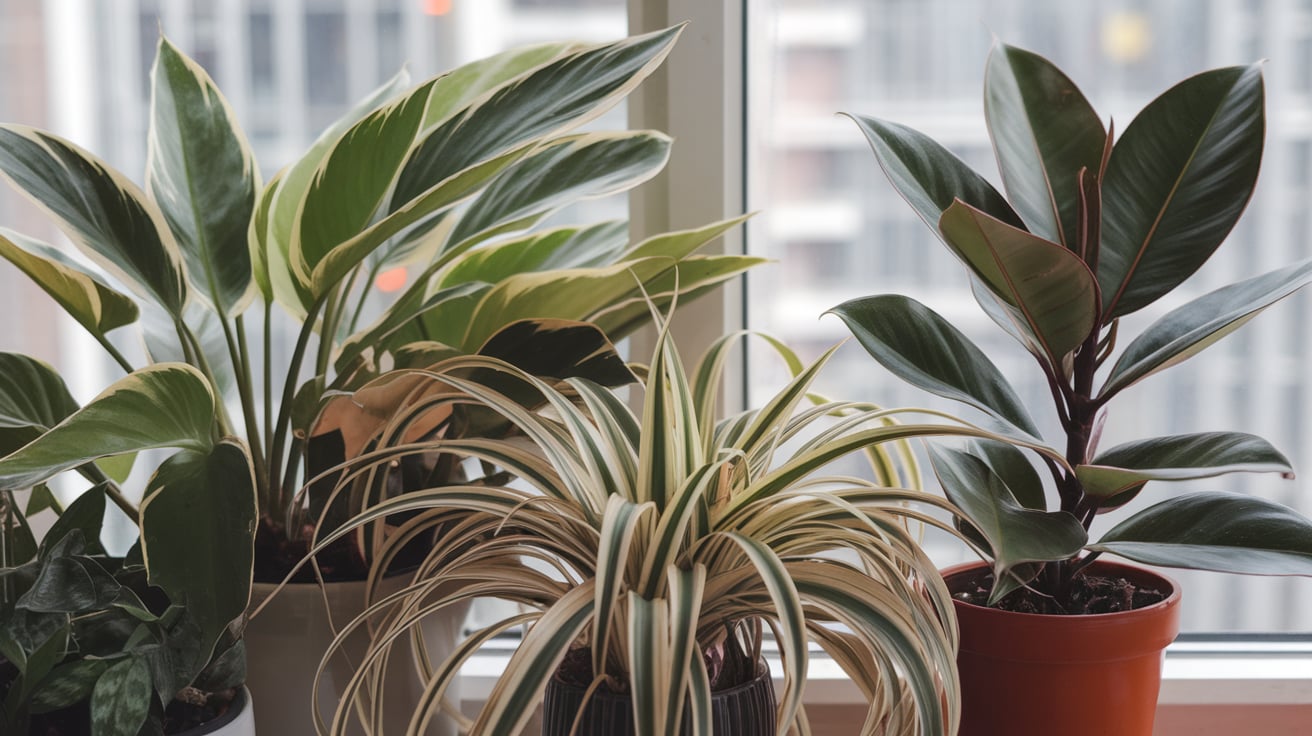Yellowing leaves are among the most common issues faced by houseplant owners, affecting nearly 80% of indoor gardeners at some point. This discoloration—technically called chlorosis—isn’t just an aesthetic concern; it’s your plant’s way of communicating distress. When left unaddressed, what starts as a few yellow leaves can progress to widespread decline, susceptibility to pests and diseases, and potentially plant death.
Different houseplants exhibit yellowing for specific reasons based on their native environments and care requirements. Understanding these plant-specific causes is crucial for effective treatment and can save you from the frustration of applying generic solutions that may not work for your particular plant.
Contents
- 1 Problem Identification: Recognizing Yellowing Patterns
- 2 Main Causes: Plant-Specific Yellowing Analysis
- 3 Solution Strategies: Plant-Specific Remedies
- 4 Prevention Strategies: Keeping Yellowing at Bay
- 5 Frequently Asked Questions
- 5.1 Q: Can yellow leaves turn green again?
- 5.2 Q: Why are my plant’s new leaves yellowing while older ones look fine?
- 5.3 Q: How quickly should I act when I notice yellowing leaves?
- 5.4 Q: Can seasonal changes cause temporary yellowing that resolves itself?
- 5.5 Q: Is yellowing contagious between houseplants?
- 6 Conclusion: Mastering Plant-Specific Yellowing
Problem Identification: Recognizing Yellowing Patterns

Clear Symptom Descriptions
Yellowing manifests differently across plant varieties:
-
Uniform yellowing: The entire leaf turns yellow evenly
-
Interveinal yellowing: Leaf veins remain green while tissue between them yellows
-
Pattern-based yellowing: Yellow spots, patches, or specific patterns emerge
-
Progressive yellowing: Starting at leaf edges/tips and moving inward, or vice versa
Distinguishing from Similar Issues
Don’t confuse yellowing with:
-
Variegation: Natural color patterns that are stable and often symmetrical
-
Sunburn: Brown, crispy patches with clear damage to leaf tissue
-
Disease spots: Usually accompanied by unusual texture changes or fungal growth
Simple Confirmation Methods
To confirm problematic yellowing:
- Check if yellowing leaves feel different (softer/mushier) than healthy leaves
- Note if yellowing is accompanied by leaf drop
- Observe if new growth is also affected or only mature leaves
- Document progression speed (sudden vs. gradual yellowing)
Main Causes: Plant-Specific Yellowing Analysis

Monstera Deliciosa Yellowing
Cause 1: Improper Watering
Monsteras display distinct yellowing patterns based on water issues:
-
Overwatering: Lower leaves yellow uniformly, often feeling soft and mushy. The soil remains wet for days, and you might notice a musty smell.
-
Underwatering: Yellowing begins at leaf edges and tips, with leaves feeling crispy rather than soft. Soil pulls away from the pot edges when dry.
Cause 2: Light Issues
Monsteras are understory plants in nature, requiring bright indirect light:
-
Too much light: Yellowing appears as bleached patches on leaves most exposed to light
-
Insufficient light: Overall pale yellowish-green color develops across all leaves, with slow or stunted growth
Cause 3: Nutrient Deficiencies
Monsteras commonly show deficiencies through specific yellowing patterns:
-
Nitrogen deficiency: Older, lower leaves turn yellow first, progressing up the plant
-
Magnesium deficiency: Interveinal yellowing while veins remain green, typically on older leaves
-
Iron deficiency: Interveinal yellowing on new growth first, with veins remaining green
Pothos (Epipremnum aureum) Yellowing
Cause 1: Inconsistent Watering
Pothos show clear signals related to watering problems:
-
Overwatering: Multiple leaves yellow simultaneously, often with brown spots developing
-
Underwatering: Yellowing begins at leaf tips and gradually spreads, with leaves feeling papery
Cause 2: Temperature Stress
Pothos are sensitive to temperature extremes:
-
Cold drafts: Yellowing appears on leaves closest to windows, doors, or AC vents
-
Heat stress: Leaves develop yellow patches that may turn brown in the center
Cause 3: Natural Aging
Unlike other causes, natural aging in pothos:
- Affects only the oldest leaves (typically near the soil)
- Progresses slowly and systematically
- Doesn’t spread to newer growth
Snake Plant (Sansevieria) Yellowing
Cause 1: Overwatering
The primary cause of snake plant yellowing:
- Leaves develop soft, yellow patches that may appear water-soaked
- Yellowing often starts at the base of leaves and moves upward
- Root rot may be present if you gently tug the plant and feel little resistance
Cause 2: Light Exposure Issues
Snake plants show specific light-related yellowing:
-
Too much direct sun: Yellowing appears as bleached areas or sunburn
-
Extremely low light: Gradual, overall yellowing with very slow progression
Cause 3: Pest Infestation
Snake plants may yellow due to pests:
- Spider mites cause stippled yellowing and fine webbing
- Mealybugs create cotton-like residue near yellowing areas
Peace Lily (Spathiphyllum) Yellowing
Cause 1: Water Quality Issues
Peace lilies are sensitive to water chemicals:
- Chlorine/fluoride toxicity causes leaf tips and edges to yellow first
- Salt buildup from fertilizer creates a crusty soil surface with yellowing leaf edges
Cause 2: Lighting Problems
Peace lilies show specific light-related yellowing:
-
Too much light: Scorched yellow patches on leaves most exposed to light
-
Too little light: General yellowing of older leaves with pale new growth
Cause 3: Humidity Issues
As tropical plants, peace lilies react to low humidity:
- Leaf edges turn yellow and brown
- Yellowing is often accompanied by leaf curling
Solution Strategies: Plant-Specific Remedies
For Monstera Deliciosa
Addressing Watering Issues:
-
For overwatering: Allow soil to dry out to the top 2-3 inches before watering again. If severe, repot in fresh, well-draining soil after trimming any rotted roots.
-
For underwatering: Establish a consistent watering schedule based on environmental conditions—typically when the top 1-2 inches of soil feels dry. Consider bottom-watering to ensure thorough moisture.
Fixing Light Problems:
-
Too much light: Move your monstera 3-5 feet away from windows or add a sheer curtain to filter direct sunlight.
-
Insufficient light: Relocate to a brighter spot with indirect light, ideally near an east or north-facing window. Avoid sudden changes—acclimate gradually over 1-2 weeks.
Correcting Nutrient Deficiencies:
-
For nitrogen deficiency: Apply a balanced liquid fertilizer (NPK 10-10-10) diluted to half-strength every 4-6 weeks during growing season.
-
For magnesium deficiency: Dissolve 1 tablespoon of Epsom salts in 1 gallon of water and apply monthly during growing season.
-
For iron deficiency: Apply chelated iron according to package directions, or consider a soil acidifier if your soil pH is too high.
For Pothos
Resolving Watering Inconsistencies:
-
For overwatering: Allow soil to dry out completely between waterings. In severe cases, check for root rot and repot in fresh soil.
-
For underwatering: Soak thoroughly until water runs from drainage holes, then establish a regular watering schedule based on environmental conditions.
Addressing Temperature Stress:
-
For cold drafts: Relocate plants away from doors, windows, and AC vents. Maintain temperatures between 65-85°F (18-29°C).
-
For heat stress: Move away from heat sources and increase humidity by grouping plants or using a humidifier.
Managing Natural Aging:
- Selectively prune yellowing older leaves at the base of stems
- Propagate healthy stem cuttings to rejuvenate the plant
- Maintain regular fertilization during growing season (spring/summer) to support new growth
For Snake Plants
Correcting Overwatering:
- Immediately stop watering and allow soil to dry completely
- If severe, unpot the plant, remove rotted roots, and repot in fresh, very well-draining soil
- Establish a minimal watering routine—typically once every 3-4 weeks in growing season and even less in winter
Adjusting Light Exposure:
-
For too much sun: Move to a location with bright indirect light or filtered sun
-
For low light: Gradually move to a brighter location, avoiding sudden changes that could shock the plant
Eliminating Pests:
- For spider mites: Wipe leaves with a damp cloth, then spray with insecticidal soap every 7-10 days for three applications
- For mealybugs: Remove visible bugs with alcohol-dipped cotton swabs, then treat with neem oil every 7-10 days
For Peace Lily
Addressing Water Quality:
- Use filtered, distilled, or rainwater instead of tap water
- If using tap water, let it sit out overnight to allow chlorine to dissipate
- Flush the soil thoroughly every 2-3 months to remove salt buildup
Correcting Light Issues:
-
For too much light: Move to a location with bright indirect light, avoiding direct sun
-
For insufficient light: Place near a north or east-facing window, or supplement with grow lights
Improving Humidity:
- Group with other plants to create a microclimate
- Place on a pebble tray with water (ensuring pot doesn’t sit directly in water)
- Run a humidifier nearby, aiming for 50-60% humidity
Prevention Strategies: Keeping Yellowing at Bay
Daily Care Adjustments
Watering Best Practices:
- Develop plant-specific watering schedules based on individual needs rather than calendar dates
- Check soil moisture with your finger or a moisture meter before watering
- Water thoroughly until it drains, then empty saucers to prevent standing water
Light Management:
- Rotate plants quarterly to ensure even light exposure
- Adjust plant positions seasonally as sun angles change
- Use sheer curtains to diffuse harsh direct sunlight
Proactive Nutrition:
- Apply diluted fertilizer (half-recommended strength) during active growth periods
- Flush soil every 2-3 months to prevent salt buildup
- Consider slow-release fertilizers for consistent nutrient delivery
Seasonal Prevention Measures
Spring/Summer:
- Increase monitoring for pests as activity increases
- Adjust watering frequency as temperatures rise
- Provide additional humidity during air-conditioned months
Fall/Winter:
- Reduce watering frequency as growth slows
- Move plants away from drafty windows and heat sources
- Hold off on fertilizing during dormancy periods
Recommended Prevention Tools and Products
For Monitoring:
- Soil moisture meters ($10-15)
- Digital hygrometers for humidity tracking ($12-20)
- Plant monitoring apps like Planta or Greg
For Prevention:
- Self-watering pots for consistent moisture ($15-40)
- Humidifiers designed for plants ($30-60)
- Quality potting mixes specific to plant types ($8-15)
- Organic preventative pest sprays like neem oil ($10-15)
Frequently Asked Questions
Q: Can yellow leaves turn green again?
A: Unfortunately, once a leaf has turned yellow, it won’t revert to green. The chlorophyll breakdown that causes yellowing is irreversible. Focus on addressing the underlying cause to protect remaining healthy leaves and encourage new growth. You can safely prune yellow leaves once you’ve identified and fixed the problem.
Q: Why are my plant’s new leaves yellowing while older ones look fine?
A: When new growth yellows but mature leaves remain healthy, this typically indicates:
- Iron or manganese deficiency (common in plants that prefer acidic soil)
- Pest infestation targeting tender new growth
- Sudden environmental changes that new leaves haven’t adapted to
Check the undersides of leaves for pests, test soil pH, and ensure you haven’t recently relocated the plant or changed care routines.
Q: How quickly should I act when I notice yellowing leaves?
A: Address yellowing promptly but don’t panic. Isolated yellowing of one or two older leaves may be natural aging. However, if you notice multiple leaves yellowing within a short period, or a pattern of yellowing spreading through the plant, take action within 1-2 days. Quick response can prevent stress from affecting the entire plant.
Q: Can seasonal changes cause temporary yellowing that resolves itself?
A: Yes, seasonal transitions can trigger temporary yellowing, particularly in fall and winter when light levels decrease. Plants may shed some older leaves as they adjust to lower light conditions. This natural adaptation usually stabilizes once the plant acclimates. However, dramatic or widespread yellowing still warrants investigation.
Q: Is yellowing contagious between houseplants?
A: Yellowing itself isn’t contagious, but if it’s caused by pests or disease, these can spread between plants. If you notice yellowing accompanied by unusual spots, sticky residue, or visible insects, isolate the affected plant immediately while you diagnose the problem. Always clean tools between plants to prevent potential cross-contamination.
Conclusion: Mastering Plant-Specific Yellowing
Understanding the unique yellowing patterns of your specific houseplants empowers you to provide targeted care rather than generic solutions. Remember these key points:
- Yellowing is a symptom with multiple potential causes, and the pattern provides important diagnostic clues
- Different plants yellow for different primary reasons—monstera for light and water issues, pothos for inconsistent care, snake plants almost exclusively from overwatering, and peace lilies from water quality problems
- Prevention through plant-specific care routines is more effective than reactive treatment
- Quick intervention when yellowing appears can prevent minor issues from becoming major problems
By learning your plants’ specific language of distress, you transform from a reactive plant owner into a proactive plant partner. Each yellowing leaf becomes less a frustration and more an opportunity to deepen your understanding of your green companions’ unique needs.
Your houseplants communicate with you constantly—learning to read these signals is the difference between struggling with constant problems and cultivating a thriving indoor garden. With the specific knowledge you’ve gained, you’re well-equipped to keep your favorite houseplants vibrant and healthy for years to come.








